
ExtremePackaging
A Modular Architecture Methodology for Swift Projects By Mihaela Mihaljevic
Introduction
Extreme Packaging is a methodology for structuring Swift projects with maximal modularity and minimal responsibility per module. Each module represents a single, isolated unit of logic — small enough to reason about, easy to test, and replaceable without side effects.
The core idea is separation: modules depend on stable interfaces, not on each other’s implementations. This enables scalable architectures that remain flexible as projects evolve, while keeping build times short and dependencies explicit.
Table Of Contents:
Goals
- Promote clean boundaries between domains and features
- Enable independent development and testing per package
- Simplify refactoring and dependency management
- Keep compilation fast and the architecture transparent
Process
The repository is organized into stages, each representing a self-contained checkpoint in the project’s evolution. When moving between stages — especially when reverting to earlier ones — always reset and clean your workspace to ensure it matches the intended state.
Here’s the example for stage 01:
# Ensure you're on the branch you want
git checkout stage/01-init-packages
# Fetch the latest version
git fetch origin
# Reset your branch to the remote version
git reset --hard stage/01-init-packages
# Delete untracked files and directories
git clean -fdx
Philosophy
In most projects, modularization is an afterthought — introduced when the codebase becomes too large to manage. Extreme Packaging inverts that approach: modularization is the starting point. By treating each package as an autonomous component from day one, you gain clarity, resilience, and a foundation that naturally scales with complexity.
Part 1 — Project Setup
The first step in Extreme Packaging is establishing a clear and reproducible project structure that can evolve gradually through defined stages. Each stage in the repository builds upon the previous one — from the initial package setup, to workspace creation, and finally to adding the app target that ties everything together.
Overview
The project begins as a Swift Package Manager–based structure, designed for modularity from the start. At its core is a single Packages directory that houses all functional modules (such as AppFeature, SharedModels, and later others). Every addition to the project — whether a new feature, UI layer, or platform target — is layered on top of this foundation in small, trackable increments.
Here is the link to the project used: https://github.com/mihaelamj/ExtremePackaging
1.1 Stage 01 — Initialize Packages
Purpose
This stage ensures a working, self-contained Swift package that compiles and passes initial linting checks.
Parts
At stage/01-init-packages, the repository contains:
- A minimal package structure with
SourcesandTests - Core configuration files:
.swiftlint.ymlfor linting rules.swiftformatfor consistent formatting.gitignore,LICENSE, andREADME.md
- Two base modules:
AppFeature— serves as the entry feature for the appSharedModels— holds simple model definitions
Folder Structure snapshot
Example folder structure: 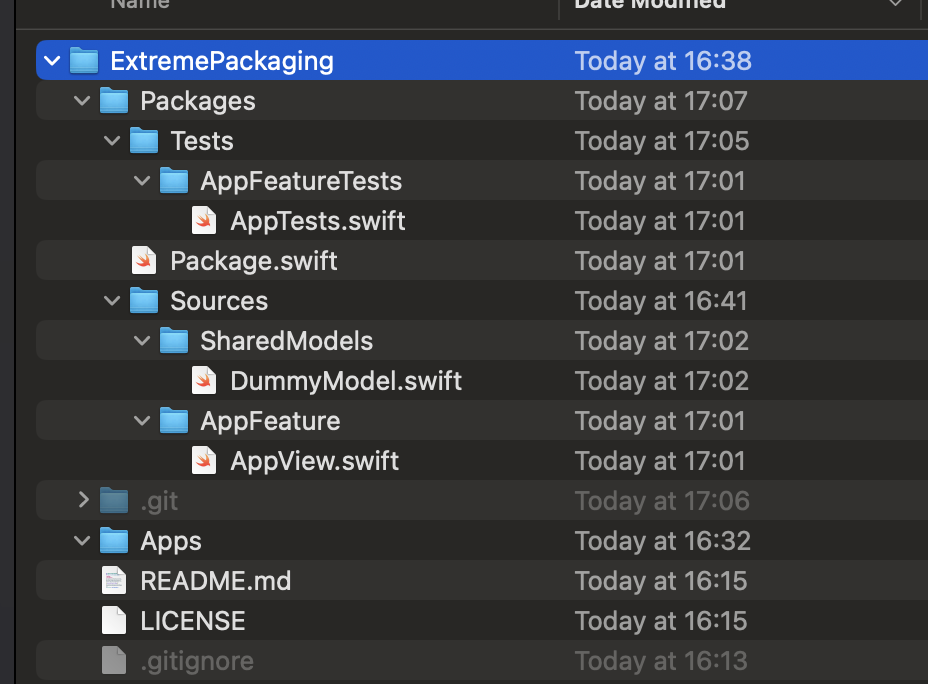
Inside the folder:
➜ ExtremePackaging git:(main) ✗ ls -all
.
..
.git
.gitignore
.swiftformat
.swiftlint.yml
Apps
LICENSE
Packages
README.md
Inside the Packages folder:
➜ ExtremePackaging git:(main) cd Packages
➜ Packages git:(main) ls -all
.
..
Package.swift
Sources
Tests
Inside the Apps folder:
.
..
.gitkeep
Basic Package Code:
I start with package structure like this:
// swift-tools-version: 6.0
import PackageDescription
let package = Package(
name: "Main",
platforms: [
.iOS(.v17),
.macOS(.v14),
],
products: [
.singleTargetLibrary("AppFeature"),
],
dependencies: [
.package(url: "https://github.com/realm/SwiftLint", exact: "0.52.3"),
],
targets: [
.target(
name: "AppFeature",
dependencies: [
"SharedModels",
]
),
.testTarget(
name: "AppFeatureTests",
dependencies: [
"AppFeature"
]
),
.target(
name: "SharedModels"
)
]
)
// Inject base plugins into each target
package.targets = package.targets.map { target in
var plugins = target.plugins ?? []
plugins.append(.plugin(name: "SwiftLintPlugin", package: "SwiftLint"))
target.plugins = plugins
return target
}
extension Product {
static func singleTargetLibrary(_ name: String) -> Product {
.library(name: name, targets: [name])
}
}
Dummy Files
AppView
import SharedModels
import SharedViews
import SwiftUI
public struct AppView: View {
public var body: some View {
VStack {
Text("Extreme Packaging!")
.font(.title)
.fontWeight(.bold)
.multilineTextAlignment(.center)
.padding()
}
}
}
DummyModel
import Foundation
public struct DummyModel: Identifiable {
public var id: UUID = .init()
public var title: String
public init(
id: UUID = .init(),
title: String
) {
self.id = id
self.title = title
}
}
Stage 01-init-packages
Here’s the code for stage 01:
# Clone repo if needed
git clone git@github.com:mihaelamj/ExtremePackaging.git
# Ensure you're on the branch you want
git checkout stage/01-init-packages
# Fetch the latest version
git fetch origin
# Reset your branch to the remote version
git reset --hard stage/01-init-packages
# Delete untracked files and directories
git clean -fdx
To see how it looks in Xcode we need to switch to subfolder packages, since we haven’t created the workspace yet.
➜ ExtremePackaging git:(stage/01-init-packages) ✗ cd Packages
➜ Packages git:(stage/01-init-packages) ✗ xed .
1.2 Stage 02 — Add Workspace
Purpose
In stage/02-workspace-added, an Xcode workspace named Main.xcworkspace is introduced at the project root. It includes the Packages folder, allowing smooth integration of multiple modules while keeping them decoupled. This step establishes the foundation for a multi-target environment.
Workspace creation steps
Create a new workspace (I name it Main), in the root of our folder.
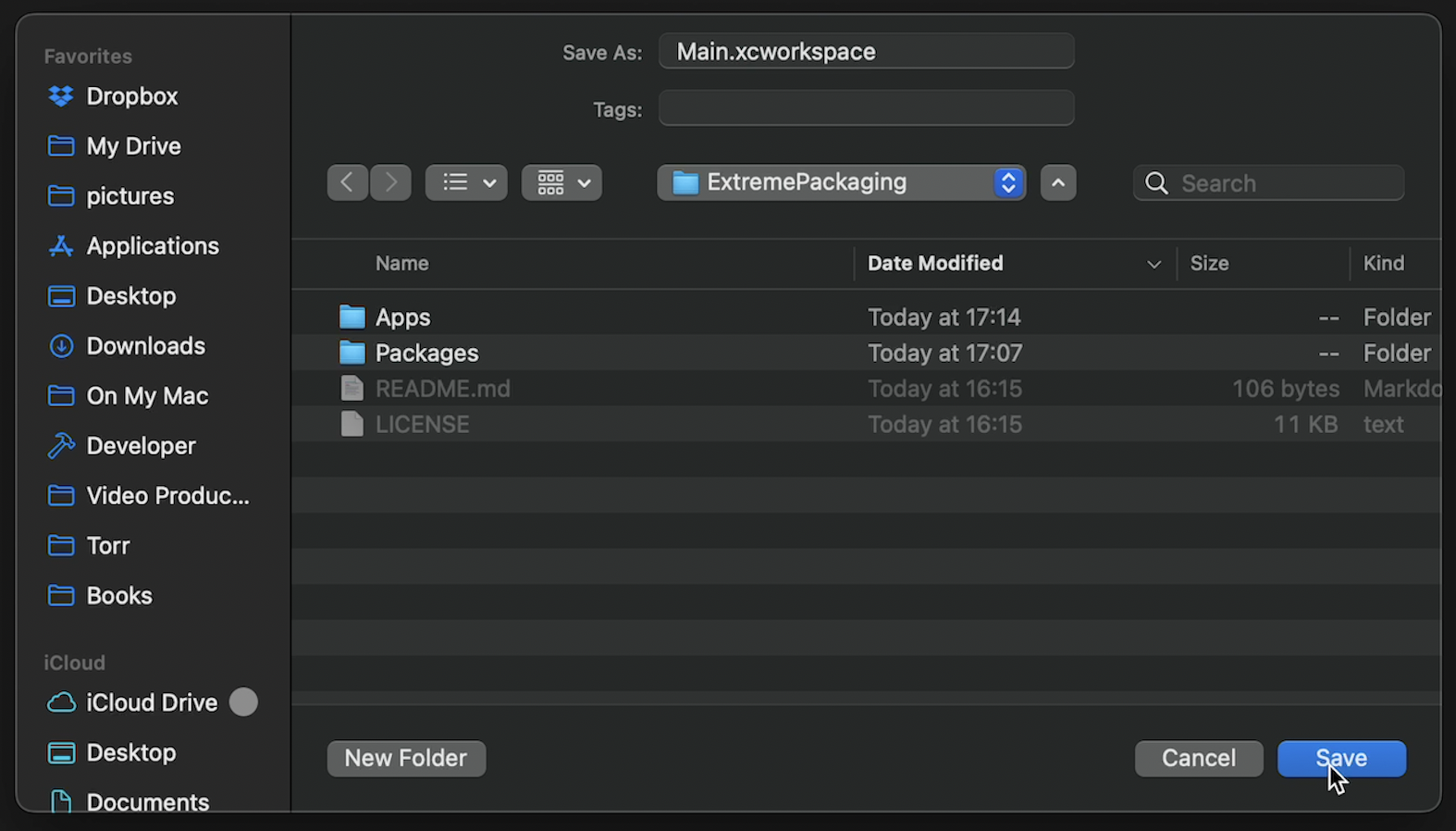
Add folder Packages to the workspace. It will add our package structure to the project:
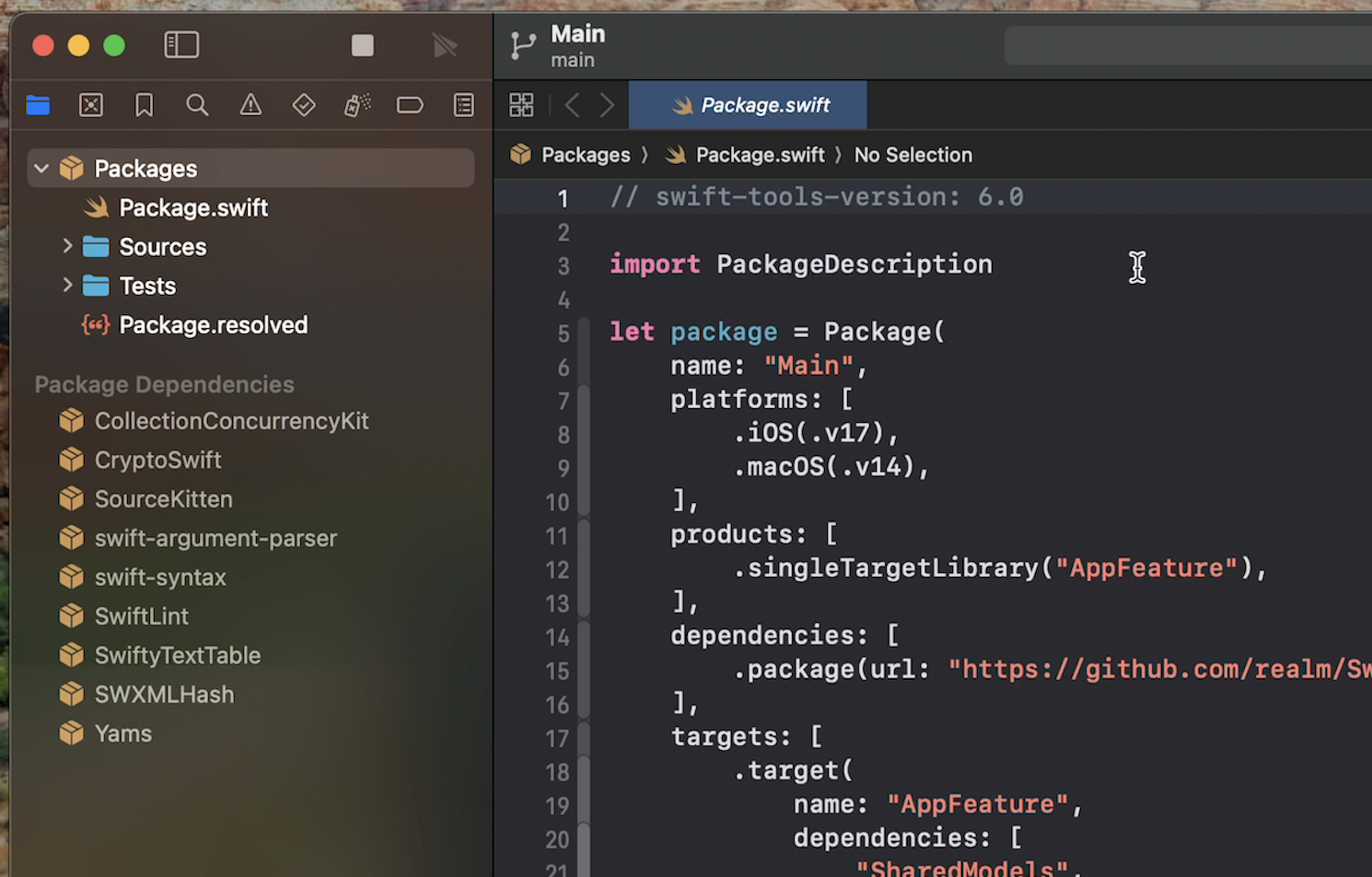
Stage 02-add—to-workspace
Here’s the code for stage 02:
# Clone repo if needed
git clone git@github.com:mihaelamj/ExtremePackaging.git
# Ensure you're on the branch you want
git checkout stage/02-add—to-workspace
# Fetch the latest version
git fetch origin
# Reset your branch to the remote version
git reset --hard stage/02-add—to-workspace
# Delete untracked files and directories
git clean -fdx
Now we have the workspace, so we just need to open Xcode:
➜ Packages git:(stage/02-add—to-workspace) ✗ xed .
➜ Packages git:(stage/02-add—to-workspace) ✗
1.3 Stage 03 — Add iOS and macOS App Targets
Platform targets creation
Add new iOS and a new macOS project Repeat this for each target:
Create a new project in Xcode:
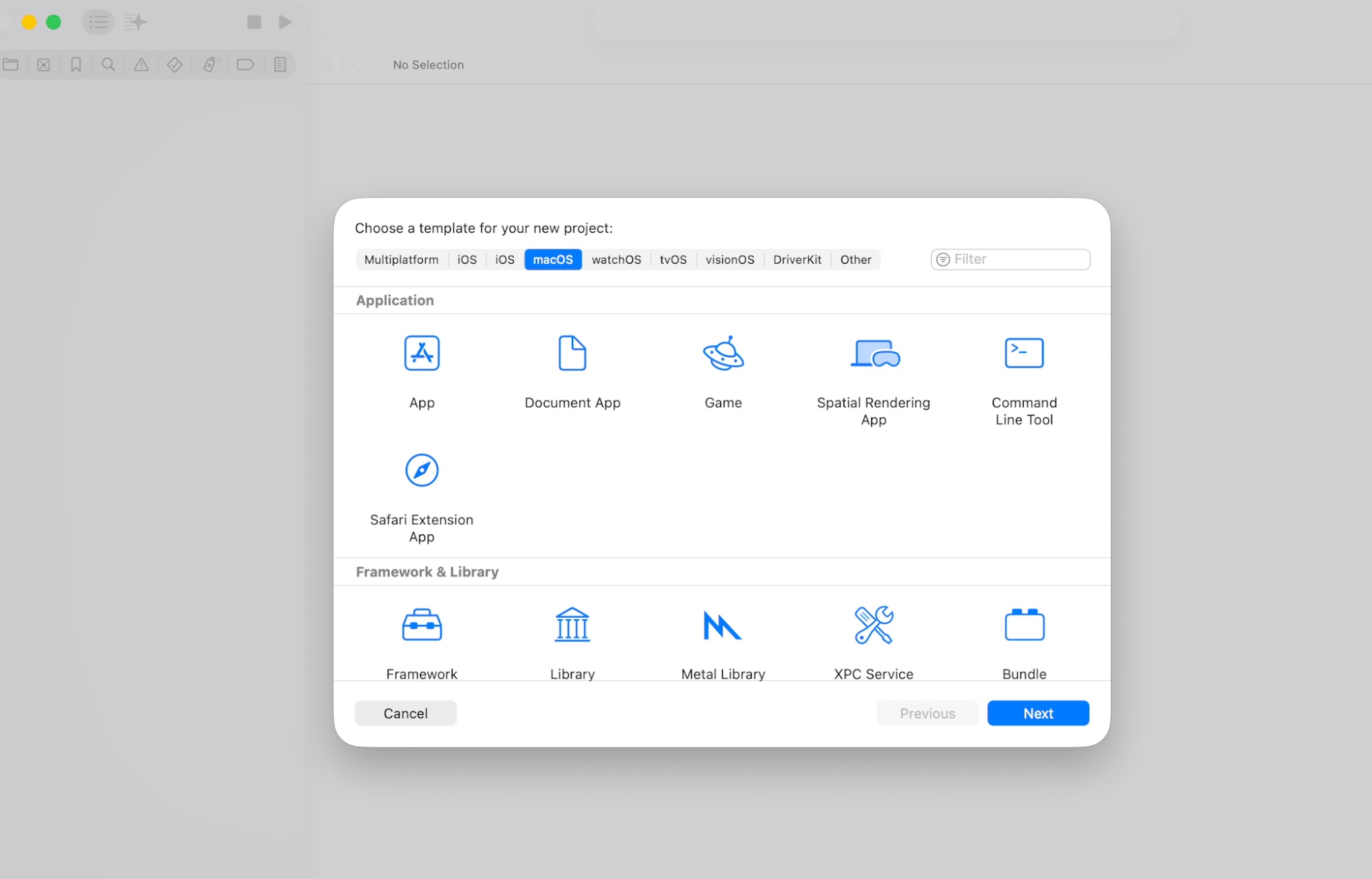
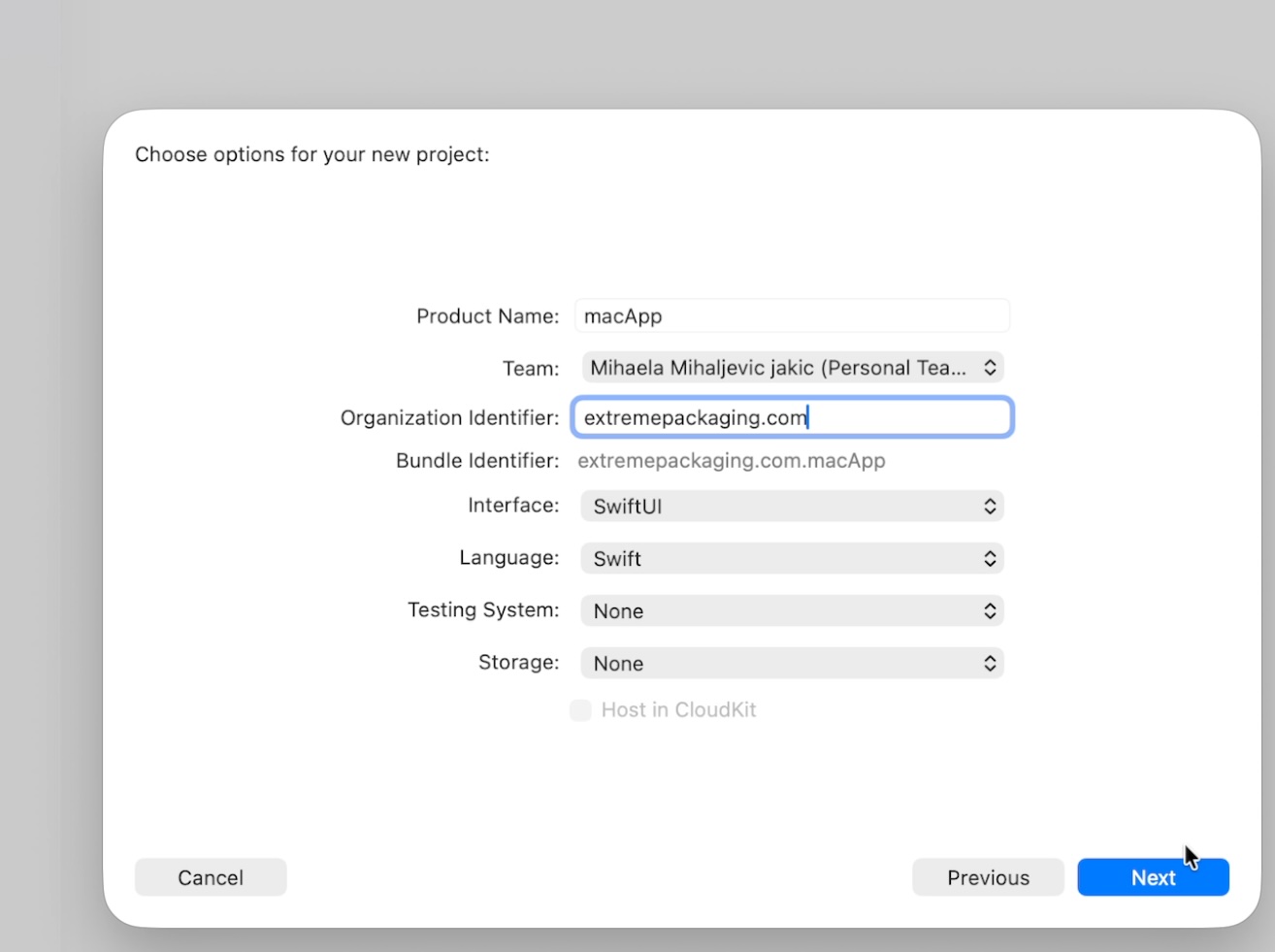
Add each to Apps folder:
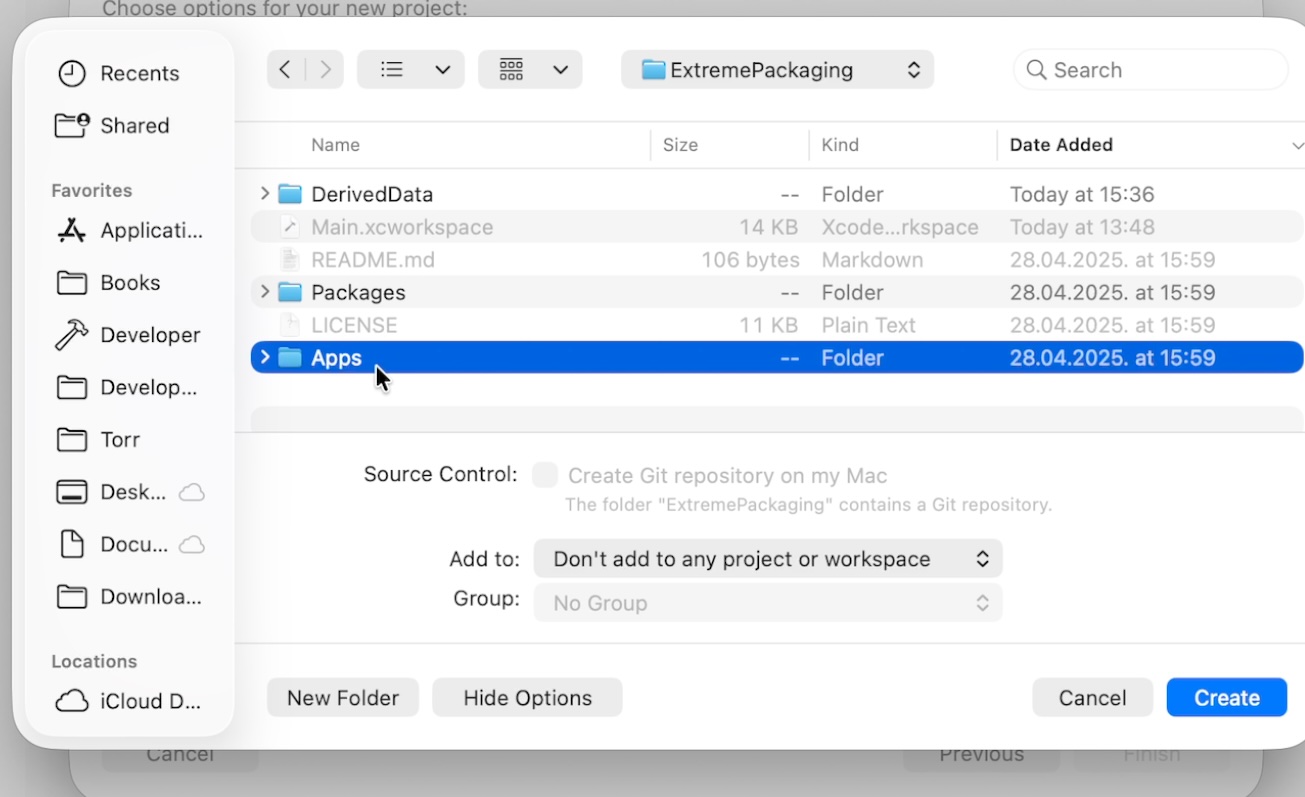
Adding them to workspace
We will be adding each app target to the workspace, below Packages. Open the current repository folder and drag both new projects (iOS and macOS) into the workspace sidebar.
Each target remains isolated within its own folder, but both share the same logic through the AppFeature module. This ensures that all common code — views, models, and reducers — stays within shared packages, while each platform target keeps its own configuration files.
Open the current repo folder: 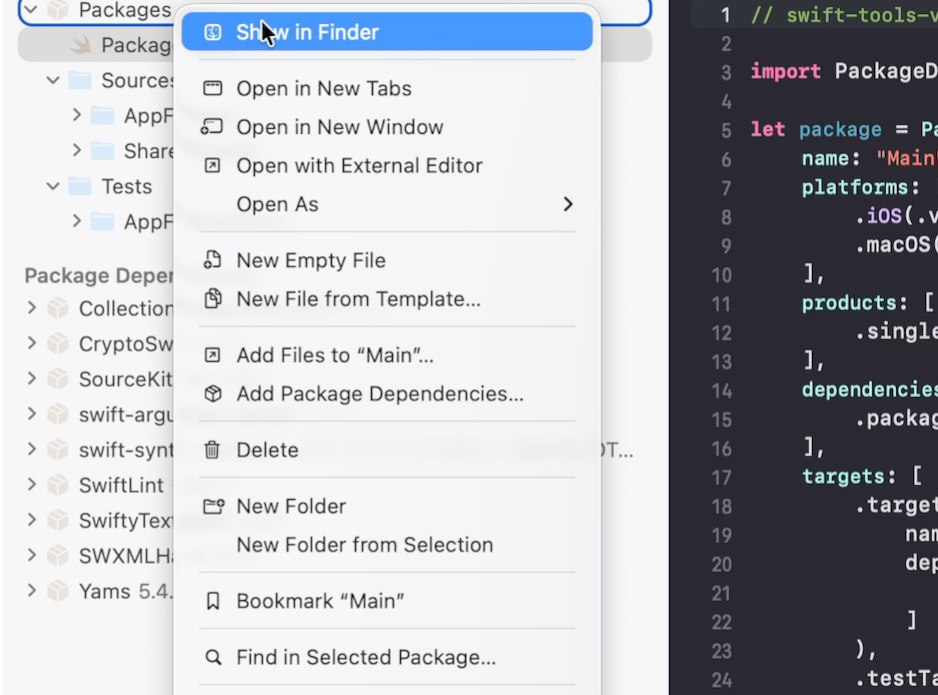
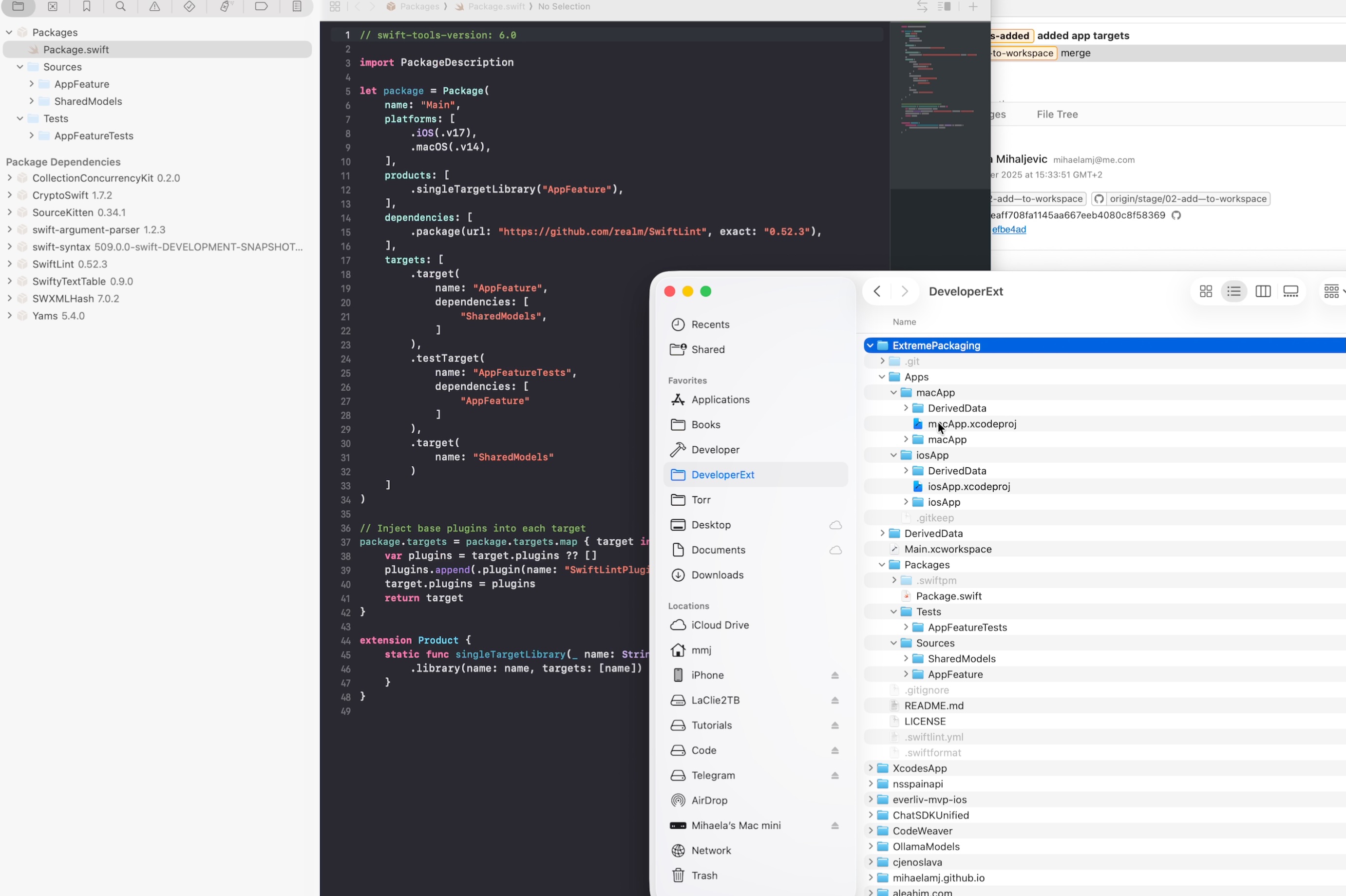
Add macOS target:
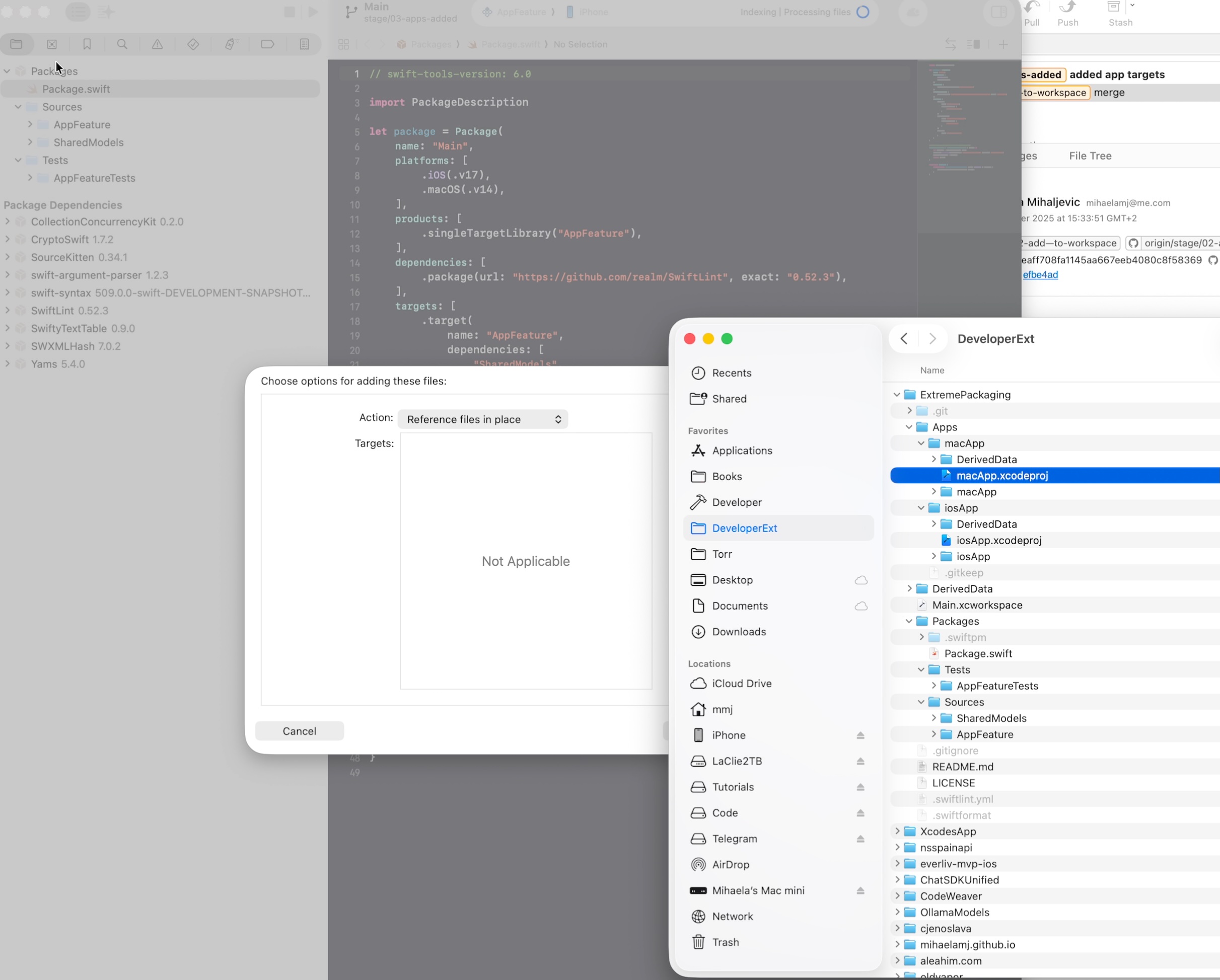
Choose “Reference files in place”
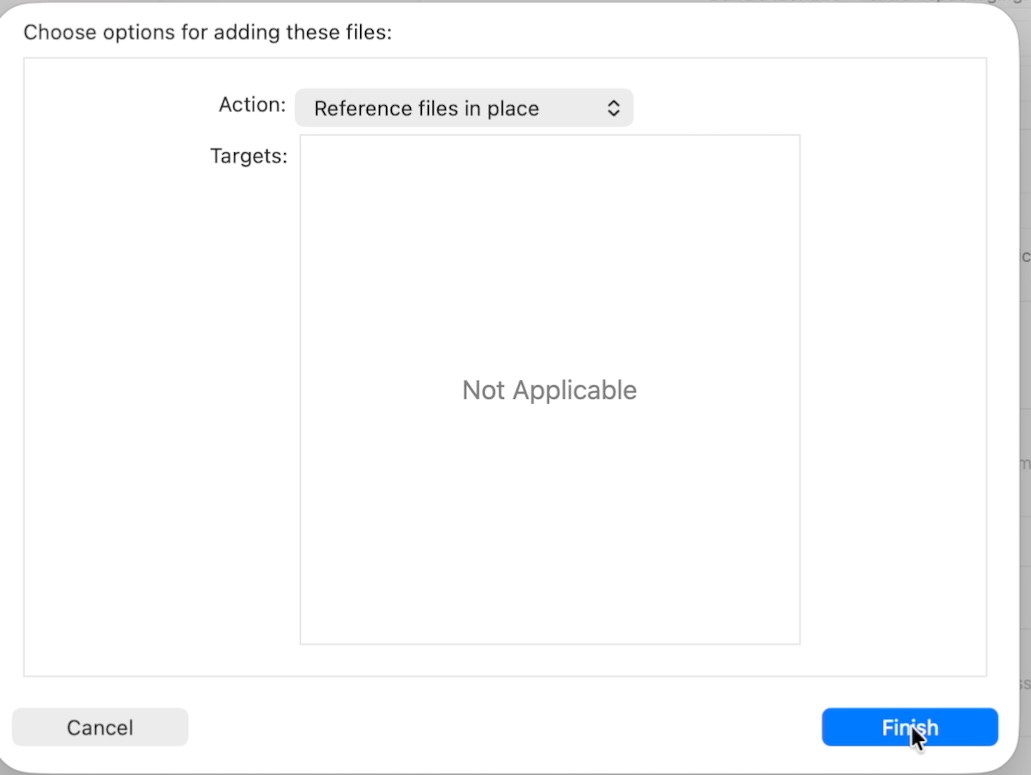
This is how it looks when added:
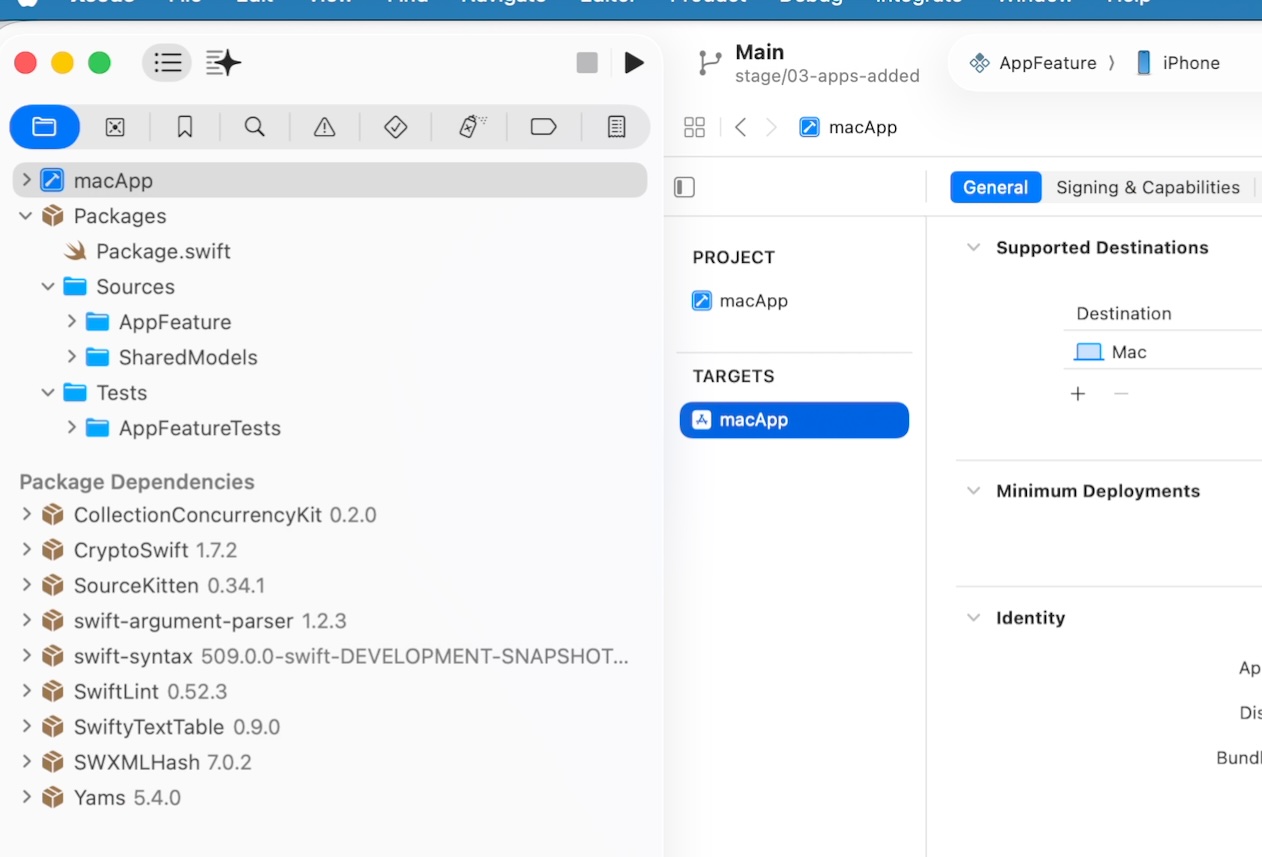
Add iOS target:
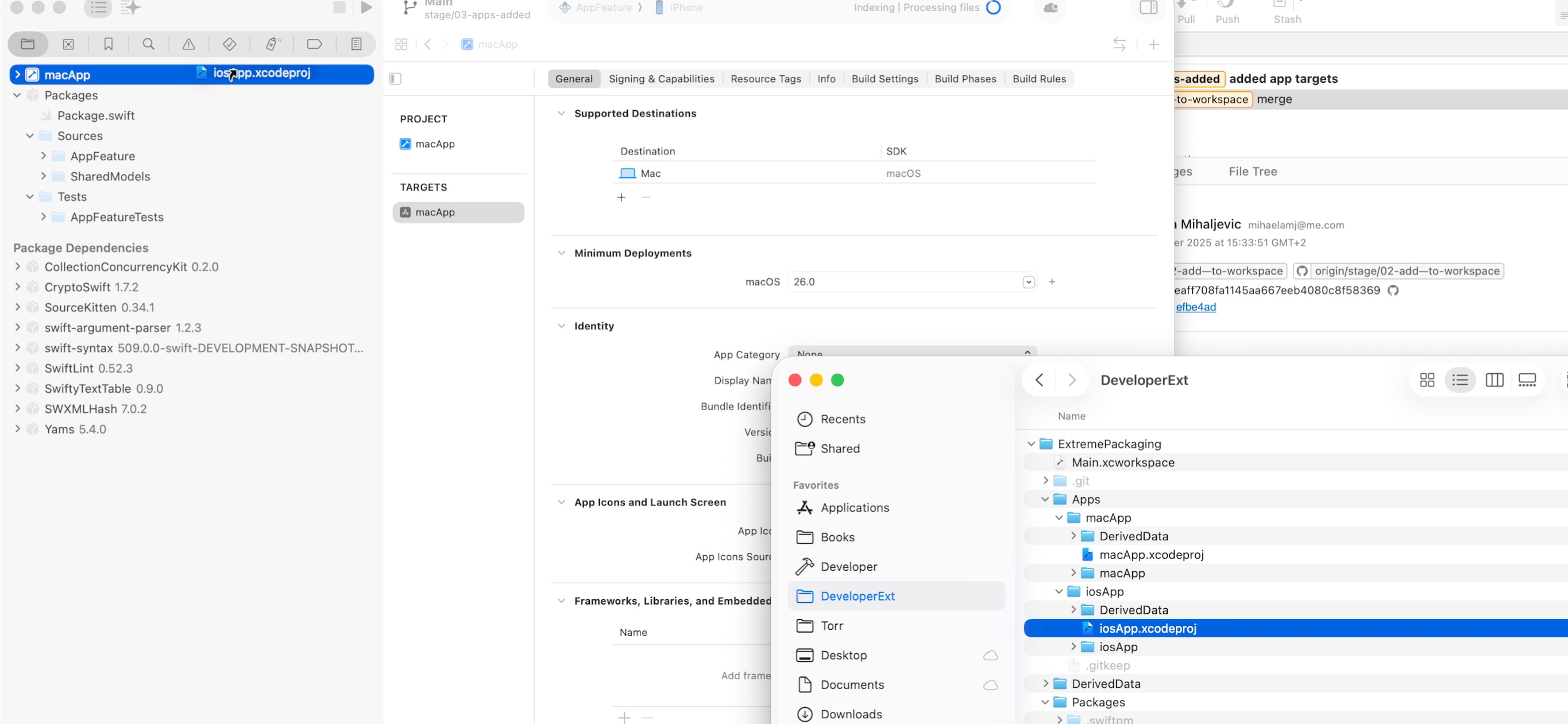
This is how it looks when added:
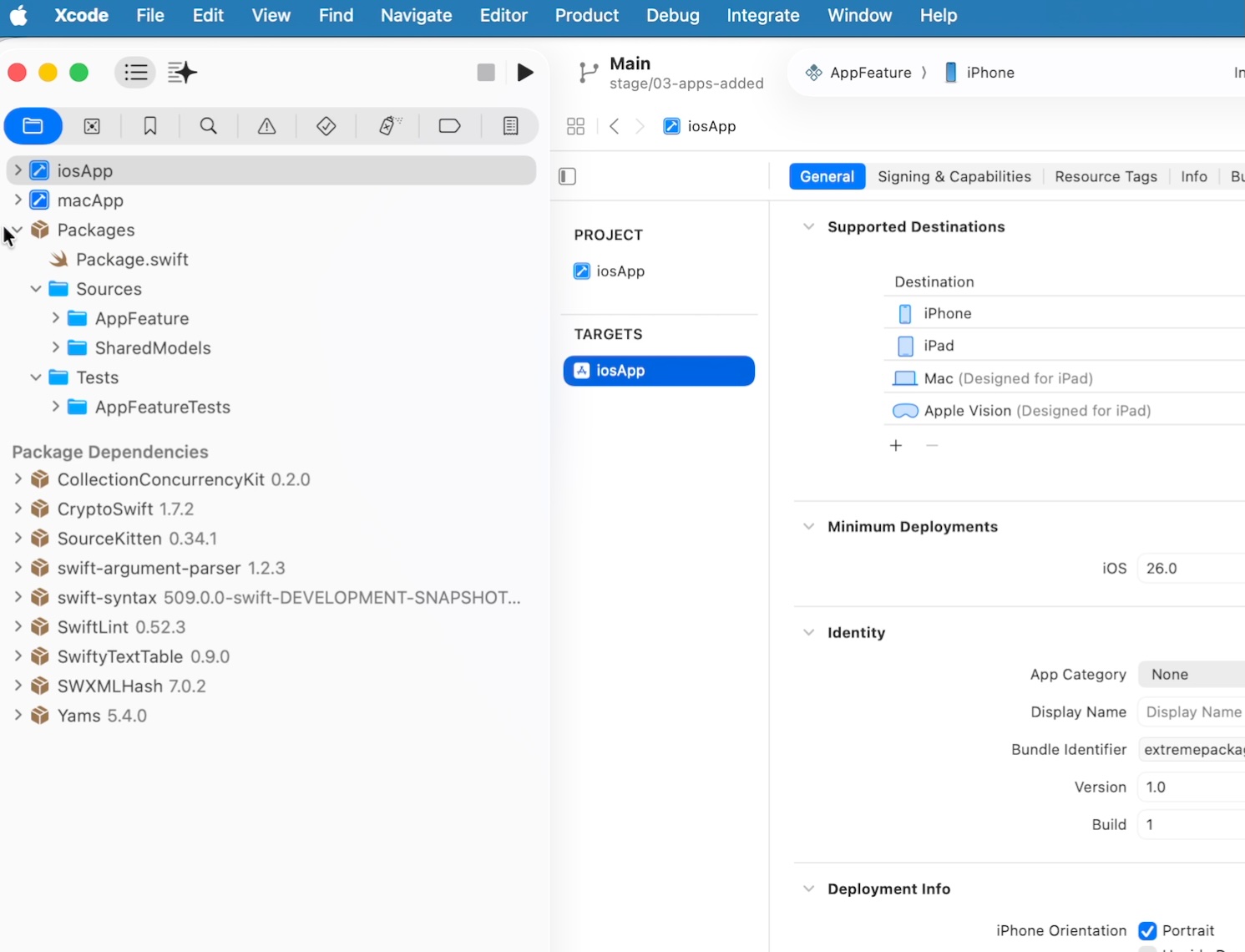
Explanation: Why separate targets
Keeping iOS and macOS projects distinct allows:
- Independent platform configuration (e.g. Info.plist, app icons, signing settings)
- Platform-specific features when needed (e.g. menu commands on macOS, touch gestures on iOS)
- Consistent architecture and shared logic through modular Swift packages
This structure aligns perfectly with the Extreme Packaging philosophy — shared foundation, platform-specific shells.
Configuration steps
- Delete automatically added
ContentView.swift - Add
AppFeaturepackage to the our target:
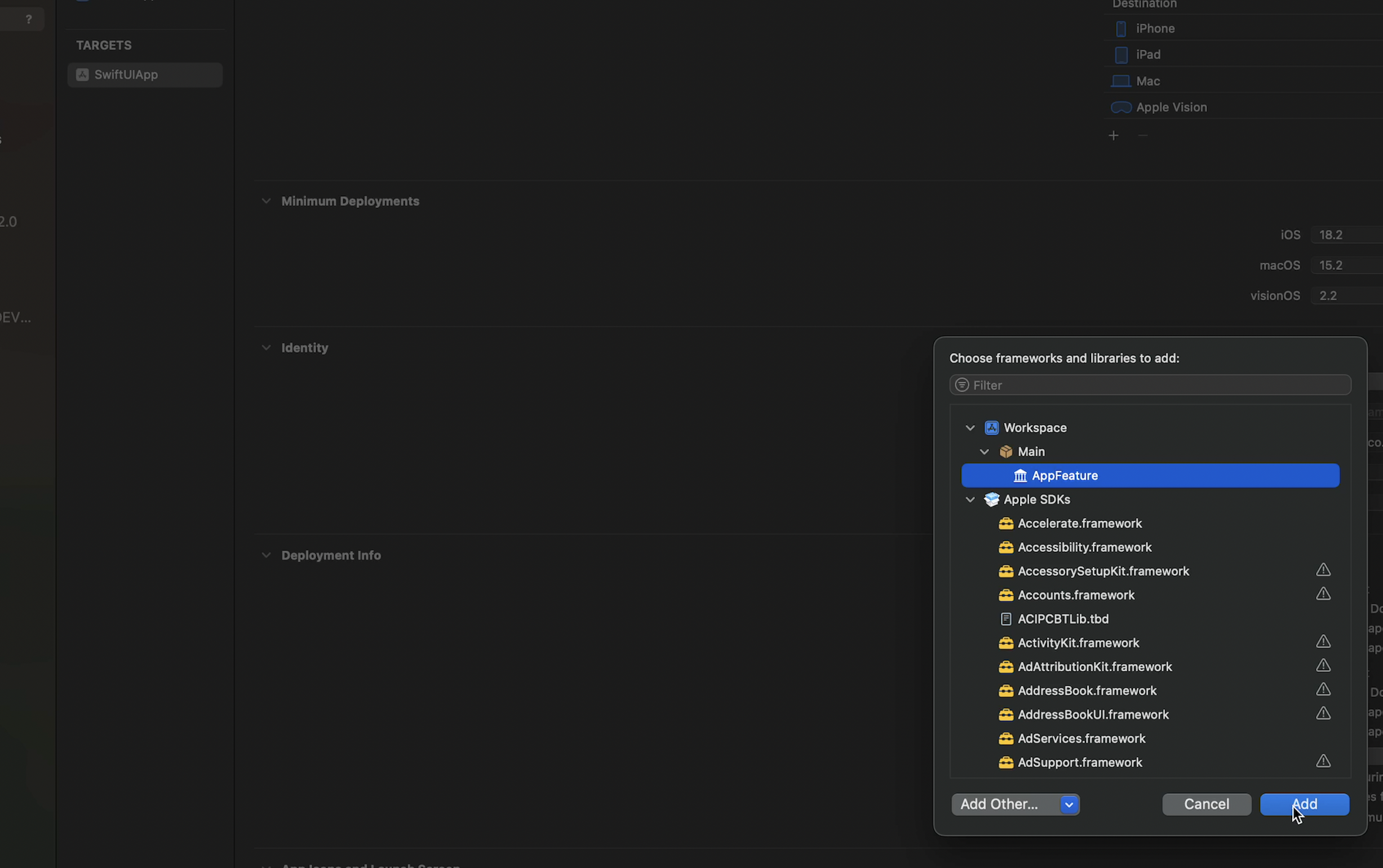
Now our project looks like this: 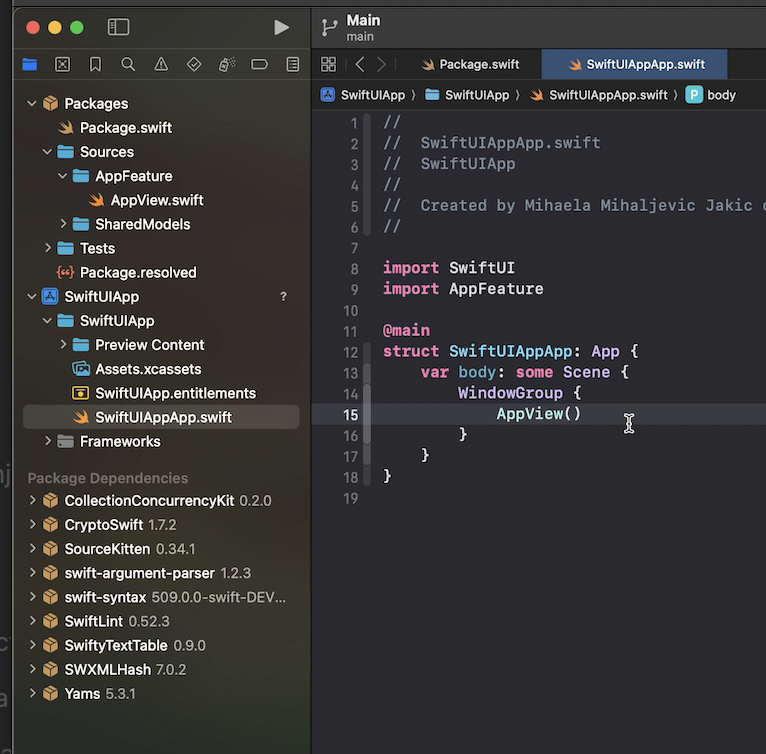
And the main app starts with the fully testable AppFeature
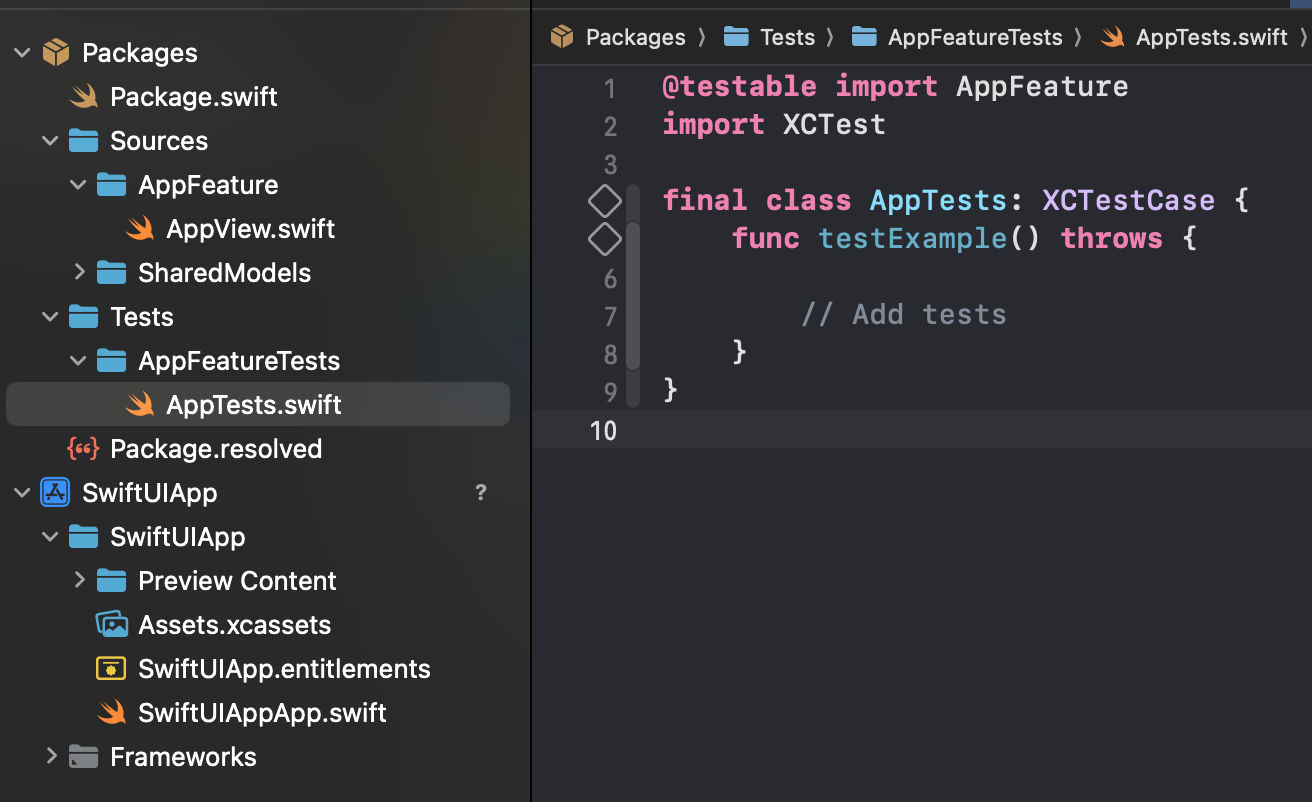
import SwiftUI
import AppFeature
@main
struct SwiftUIAppApp: App {
var body: some Scene {
WindowGroup {
AppView()
}
}
}
Final structure
At this point, the project has evolved into a fully cross-platform modular setup.
The screenshot below illustrates the final structure after completing Stage 03 (iOS & macOS targets added):
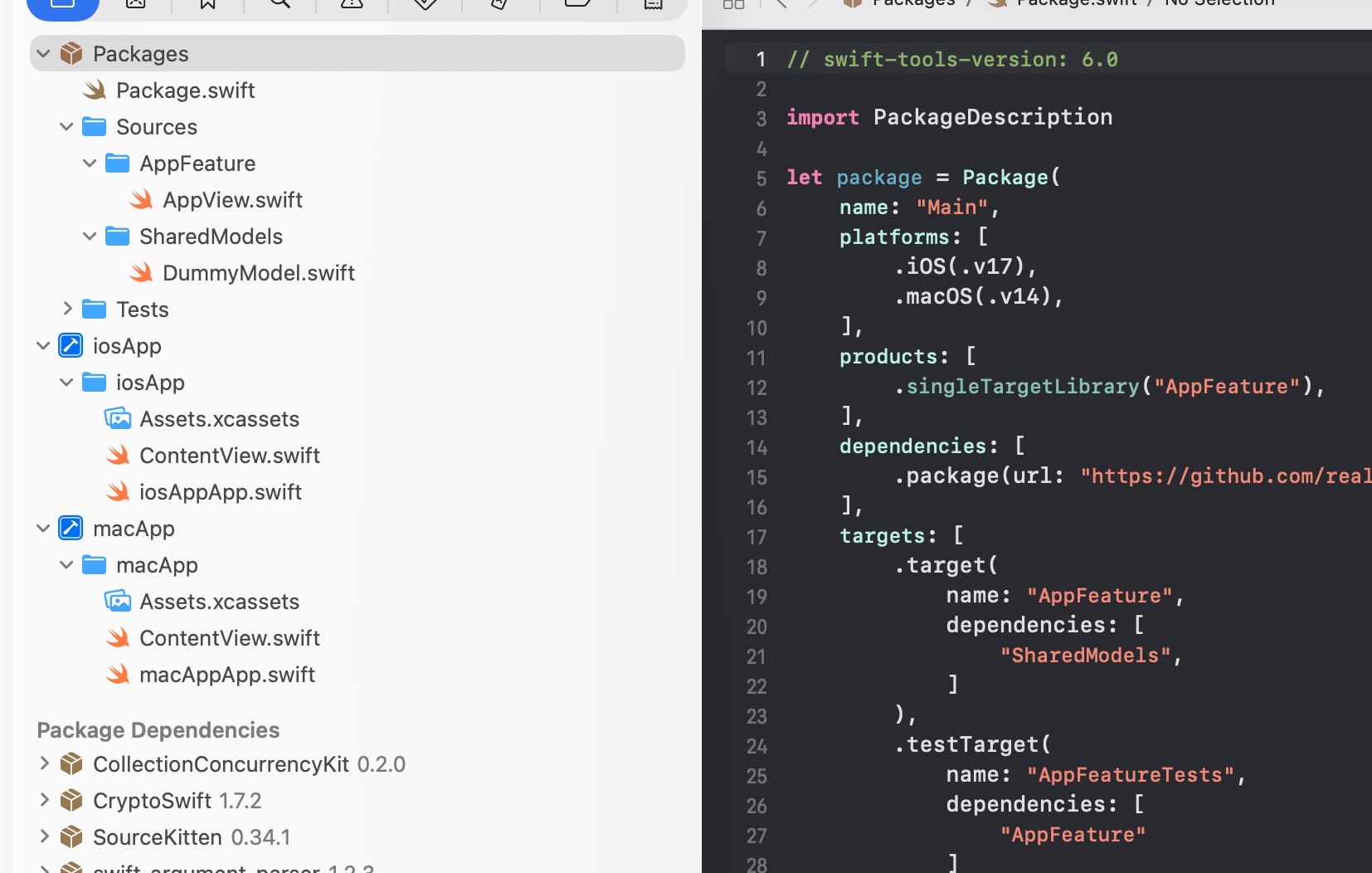
- The Packages directory defines the shared Swift Package with
AppFeatureandSharedModelsmodules. - Both iOS and macOS apps live inside the
Appsfolder, each with its own assets, entry point, and platform-specific configuration files. - The
Package.swiftfile defines a single modular product, with SwiftLint integrated as a plugin and dependencies kept cleanly separated. - This structure enables both platforms to share logic and UI built with SwiftUI, while still allowing native customization per platform.
Result: A clean, modular workspace where shared code resides in packages, and each platform acts only as a thin presentation shell — the essence of Extreme Packaging.
Stage 03-apps-added
In stage/03-apps-added, we create two separate app targets — one for iOS and one for macOS — both sharing the same SwiftUI core logic.
Each app lives inside the Apps folder and imports the AppFeature module, demonstrating how the same feature package can power multiple platforms with no duplicated code.
After adding the targets:
- Delete the automatically generated
ContentView.swift - Add the
AppFeaturepackage dependency to both targets - Verify that both apps build successfully
This stage concludes with a fully functional cross-platform setup where both iOS and macOS share a unified architecture driven by modular packages.
Here’s the code for stage 03:
# Clone repo if needed
git clone git@github.com:mihaelamj/ExtremePackaging.git
# Ensure you're on the branch you want
git checkout stage/03-apps-added
# Fetch the latest version
git fetch origin
# Reset your branch to the remote version
git reset --hard stage/03-apps-added
# Delete untracked files and directories
git clean -fdx
Summary
| Stage | Description | Key Additions |
|---|---|---|
| 01 | Initial package setup | Package.swift, SwiftLint & SwiftFormat configs, dummy modules (AppFeature, SharedModels) |
| 02 | Workspace creation | Main.xcworkspace, integrated Packages folder for modular management |
| 03 | iOS & macOS app targets added | Separate iOS and macOS apps in Apps/, both using AppFeature for shared SwiftUI logic |
Each stage corresponds to a dedicated branch in the repository, allowing you to switch between checkpoints and observe the project’s evolution step by step. This structure provides a transparent history of how a modular Swift project grows from a single package into a fully multi-platform architecture.
Part 2 — Tooling
- Every project includes SwiftLint and SwiftFormat for enforcing consistent code style and quality
- Each stage of the repository introduces incremental improvements, from initializing packages to adding app targets and integrations
- These are applied from the very first stage but can be customized at any point.
GitIgnore
# Xcode
#
# gitignore contributors: remember to update Global/Xcode.gitignore, Objective-C.gitignore & Swift.gitignore
## User settings
xcuserdata/
## Obj-C/Swift specific
*.hmap
## App packaging
*.ipa
*.dSYM.zip
*.dSYM
## Playgrounds
timeline.xctimeline
playground.xcworkspace
# Swift Package Manager
.build/
.swiftpm/
Package.resolved
# Xcode workspace & projects
*.xcworkspace/xcshareddata/WorkspaceSettings.xcsettings
*.xcworkspace/xcuserdata/
DerivedData/
*.xcuserstate
*.xcscmblueprint
*.xccheckout
# macOS system files
.DS_Store
# Carthage
Carthage/Build/
# fastlane
fastlane/report.xml
fastlane/Preview.html
fastlane/screenshots/**/*.png
fastlane/test_output
# Custom folders used in ExtremePackaging
Stage/
Tasks/.build/
SwiftFormat Config
This is my .swiftformat
# General Options
--swiftversion 5.7
# File Options
--exclude Stage,Tasks/.build,ThirdParty,**/SwiftGen/*,**/Sourcery/*,Frameworks/swift-composable-architecture,**.generated.swift
# Format Options
--allman false
--binarygrouping none
--closingparen balanced
--commas always
--conflictmarkers reject
--decimalgrouping none
--elseposition same-line
--exponentcase lowercase
--exponentgrouping disabled
--fractiongrouping disabled
--fragment false
--header ignore
--hexgrouping none
--hexliteralcase lowercase
--ifdef no-indent
--importgrouping alphabetized
--indent 4
--indentcase false
# make sure this matches .swiftlint
--maxwidth 180
--nospaceoperators ..<,...
--octalgrouping none
--operatorfunc no-space
--selfrequired
--stripunusedargs closure-only
--trailingclosures
--wraparguments before-first
--wrapcollections before-first
--wrapparameters before-first
# Rules
--disable hoistAwait
--disable hoistPatternLet
--disable hoistTry
--disable wrapMultilineStatementBraces
--disable extensionAccessControl
SwiftLint Config
disabled_rules: # rule identifiers to exclude from running
- opening_brace
- operator_whitespace
- orphaned_doc_comment
opt_in_rules:
- empty_count
- force_unwrapping
- shorthand_optional_binding
- weak_delegate
excluded:
- "*.generated"
custom_rules:
# check's for Combine's .assign(to: xxx, on: self) ref-cycle
combine_assign_to_self:
included: ".*\\.swift"
name: "`assign` to self"
regex: '\.assign\(to: [^,]*, on: self\)'
message: "For assigning on self, use assignNoRetain(to: ..., on: self)."
severity: error
duplicate_remove_duplicates:
included: ".*\\.swift"
name: "Duplicate `removeDuplicates()`"
message: "ViewStore's publisher already does `removeDuplicates()`"
regex: 'publisher\.[^(|{|,]*removeDuplicates\(\)'
severity: error
dont_scale_to_zero:
included: ".*\\.swift"
name: "Don't scale down to 0."
regex: "\\.scaleEffect\\([^\\)]*(\\ 0\\ [^\\)]*\\)|0.0(\\ |\\))|\\ 0(\\)|,))"
message: "Please make sure to pass a number not equal zero, so transformations don't throw warnings like `ignoring singular matrix`."
severity: error
use_data_constructor_over_string_member:
included: ".*\\.swift"
name: "Do not use String.data(using: .utf8)"
regex: "\\.?data\\(using: \\.utf8\\)"
message: "Please use Data(string.utf8) instead of String.data(using: .utf8) because the Data constructor is non-optional and Strings are guaranteed to be encodable as .utf8"
severity: error
tca_explicit_generics_reducer:
included: ".*\\.swift"
name: "Explicit Generics for Reducer"
regex: 'Reduce\s+\{'
message: "Use explicit generics in ReducerBuilder (Reduce
) for successful autocompletion." severity: error tca_scope_unused_closure_parameter: name: "TCA Scope Unused Closure Parameter" regex: '\.scope\(\s*state\s*:\s*\{\s*\_' message: "Explicitly use closure parameter when scoping store (ensures the right state is being mutated)" severity: error tca_use_observe_viewstore_api: name: "TCA ViewStore observe API" regex: 'ViewStore\(store\.scope' message: "Use modern observe: api instead of store.scope" severity: error trailing_comma: mandatory_comma: true cyclomatic_complexity: ignores_case_statements: true warning: 20 file_length: warning: 1000 error: 1000 identifier_name: severity: warning allowed_symbols: "_" min_length: 2 max_length: warning: 90 error: 90 excluded: - iO - id - vc - x - y - i - pi - d legacy_constant: error legacy_constructor: error line_length: warning: 180 error: 180 ignores_comments: true ignores_urls: true nesting: type_level: warning: 3 error: 3 function_level: warning: 5 error: 5 function_parameter_count: warning: 5 force_cast: warning force_unwrapping: warning type_body_length: - 300 # warning - 300 # error large_tuple: - 3 # warning - 10 # error%